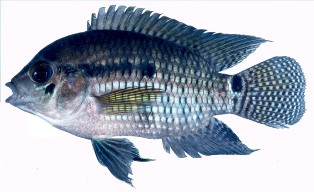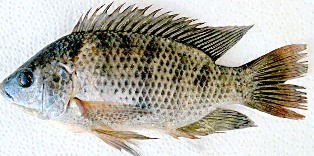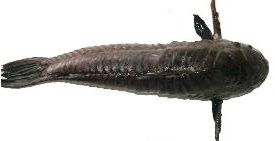Discover Florida Nature
It's time to explore the natural Florida


|
|
|
|
|
 Black
Acara (Cichlasoma bimaculatum) The black acara have a
small, stout, with a convex-headed, bream-looking body-shape with two
black blotches on side, the larger blotch at mid-body and a smaller one
near base of tail. This fishes color is variable with a
gray-blue-silver-brown base, sometimes has a light blue-green sheen.
Widespread south of Lake Okeechobee, the black acara's native range is
northern South America. The species has been established in Florida,
since the early 1960s, when it was first discovered in Dade County. They
are established in Broward, Dade, Monroe, Palm Beach, Hendry, and
Collier counties in Florida. Most commonly found in shallow, stagnant,
roadside ditches or similarly disturbed habitats that normally contain
few other fishes, the black acara can also be found infrequently in
larger canals and lakes. Early success of this fish in Florida led to an
erroneous conclusion that it would have significant negative effects on
native fishes. Their numbers have failed to increase as was predicted
since their early success in the 1970's. Their potential impact on the
Gulf of Mexico ecosystem, was apparently overestimated. Maximum size of
the black acara is about eight inches and weight about four ounces.
Black acara have low salinity tolerance which limits their access to
many brackish water localities. This species is omnivorous, feeding on
whatever is available. Black acara are very territorial, reacting
aggressively toward any fish in their proximity. They have been observed
spawning and defending nesting sites in all but the coldest months of
the year. They probably compete with native centrarchids for these
spawning sites, however, this species does not appear to be able to
compete with native fishes in undisturbed bodies of water. Black
Acara (Cichlasoma bimaculatum) The black acara have a
small, stout, with a convex-headed, bream-looking body-shape with two
black blotches on side, the larger blotch at mid-body and a smaller one
near base of tail. This fishes color is variable with a
gray-blue-silver-brown base, sometimes has a light blue-green sheen.
Widespread south of Lake Okeechobee, the black acara's native range is
northern South America. The species has been established in Florida,
since the early 1960s, when it was first discovered in Dade County. They
are established in Broward, Dade, Monroe, Palm Beach, Hendry, and
Collier counties in Florida. Most commonly found in shallow, stagnant,
roadside ditches or similarly disturbed habitats that normally contain
few other fishes, the black acara can also be found infrequently in
larger canals and lakes. Early success of this fish in Florida led to an
erroneous conclusion that it would have significant negative effects on
native fishes. Their numbers have failed to increase as was predicted
since their early success in the 1970's. Their potential impact on the
Gulf of Mexico ecosystem, was apparently overestimated. Maximum size of
the black acara is about eight inches and weight about four ounces.
Black acara have low salinity tolerance which limits their access to
many brackish water localities. This species is omnivorous, feeding on
whatever is available. Black acara are very territorial, reacting
aggressively toward any fish in their proximity. They have been observed
spawning and defending nesting sites in all but the coldest months of
the year. They probably compete with native centrarchids for these
spawning sites, however, this species does not appear to be able to
compete with native fishes in undisturbed bodies of water.  Blue
Tilapia
(Oreochromis aureus) Widespread and abundant in
Florida, blue tilapia is found in fertile lakes, ponds, rivers, streams,
and canals. It is tolerant of saltwater and found in some near shore
marine habitats, such as Tampa Bay. Young blue tilapia are a nondescript
gray with a black spot at rear of dorsal fin, while adults generally
have a blue-gray shading with white on the belly. In central Florida,
anglers can assume every tilapia they observe in fresh water is a blue,
and any tilapia over 3 pounds is also likely a blue tilapia. Blue
tilapia feed primarily on plankton and small organisms living in or on
bottom detritus. The three most common foods consumed in Lake Alice and
Lake George were diatoms, green algae, and detritus, while the dominant
food items in stomachs of fish from Six-Mile Creek near Tampa were
detritus, algae, diatoms, and plant material. Blue Tilapia grow rapidly
for their first few months, then slow somewhat but ultimately reach 5-6
pounds by age 3-5 years, with fish weighing 2-4 pounds common. The
largest blue tilapia caught in Florida weighed 10 pounds and measured
over 21 inches in length! Lake Lena blue tilapia yielded a maximum age
of 6 years, and indicated that males were larger at each age than
females. Blue
Tilapia
(Oreochromis aureus) Widespread and abundant in
Florida, blue tilapia is found in fertile lakes, ponds, rivers, streams,
and canals. It is tolerant of saltwater and found in some near shore
marine habitats, such as Tampa Bay. Young blue tilapia are a nondescript
gray with a black spot at rear of dorsal fin, while adults generally
have a blue-gray shading with white on the belly. In central Florida,
anglers can assume every tilapia they observe in fresh water is a blue,
and any tilapia over 3 pounds is also likely a blue tilapia. Blue
tilapia feed primarily on plankton and small organisms living in or on
bottom detritus. The three most common foods consumed in Lake Alice and
Lake George were diatoms, green algae, and detritus, while the dominant
food items in stomachs of fish from Six-Mile Creek near Tampa were
detritus, algae, diatoms, and plant material. Blue Tilapia grow rapidly
for their first few months, then slow somewhat but ultimately reach 5-6
pounds by age 3-5 years, with fish weighing 2-4 pounds common. The
largest blue tilapia caught in Florida weighed 10 pounds and measured
over 21 inches in length! Lake Lena blue tilapia yielded a maximum age
of 6 years, and indicated that males were larger at each age than
females. Brown
Hoplo (Hoplosternum littorale) Brown hoplo is less
than a foot long and belongs to family of fishes known as
Callichthyidae. This fish has bony armor consisting of two rows of large
hard scales forming plate-like armor along each side, it is dark brown
to black in color with two pairs of long barbells on chin. First
documented in the Indian River Lagoon system in 1995, brown hoplo is now
found throughout central and south Florida from the St. John's River to
Lake Trafford. This fish is native to eastern South America. Brown
hoplo primarily feeds on benthic invertebrates and detritus. This fish
is found in a variety of freshwater habitats including muddy bottom and
slow moving rivers, streams, side channels, ponds, marshes, and man-made
waterways such as ditches and borrow pits. Brown hoplo larvae and
juveniles inhabit shallow water areas with lots of vegetation, while
adults prefer foraging in deeper, open water areas. The brown hoplo
gulps air, and is tolerant of both low oxygen and high hydrogen-sulfide
levels. the brown hoplo grows to about 2 inches in 2 months, however it
rarely exceeds 10 inches in length. Brown hoplo is highly sought after
as food by Floridians with cultural ties to Trinidad and parts of South
America. Brown
Hoplo (Hoplosternum littorale) Brown hoplo is less
than a foot long and belongs to family of fishes known as
Callichthyidae. This fish has bony armor consisting of two rows of large
hard scales forming plate-like armor along each side, it is dark brown
to black in color with two pairs of long barbells on chin. First
documented in the Indian River Lagoon system in 1995, brown hoplo is now
found throughout central and south Florida from the St. John's River to
Lake Trafford. This fish is native to eastern South America. Brown
hoplo primarily feeds on benthic invertebrates and detritus. This fish
is found in a variety of freshwater habitats including muddy bottom and
slow moving rivers, streams, side channels, ponds, marshes, and man-made
waterways such as ditches and borrow pits. Brown hoplo larvae and
juveniles inhabit shallow water areas with lots of vegetation, while
adults prefer foraging in deeper, open water areas. The brown hoplo
gulps air, and is tolerant of both low oxygen and high hydrogen-sulfide
levels. the brown hoplo grows to about 2 inches in 2 months, however it
rarely exceeds 10 inches in length. Brown hoplo is highly sought after
as food by Floridians with cultural ties to Trinidad and parts of South
America. Bullseye Snakehead (Channa marulius) The Bullseye
Snakehead remain centered in the Margate/Coral Springs/Pompano Beach
area where it was first documented in October 2000. They will likely be
limited to the southern half of Florida since temperatures below 50oF
are lethal. Although FWC has received numerous reports of Bullseye
Snakehead elsewhere these have all turned out to be similar-looking
native fishes such as the Bowfin. Their native range Pakistan, Malaysia,
and southern China. Bullseye snakeheads are air-breathing,
torpedo-shaped fish with a flattened head and toothed jaws. These fish
have long anal and dorsal fins without spines, and typically have red
eyes. The body color of the bullseye snakehead darkens with age to deep
brown with black blotches, sometimes fringed with bright comma-shaped
markings, and a red-orange eyespot (ocellus) near the base of the tail.
It resembles a bowfin in behavior and appearance, but is distinguished
by a long anal fin. In canals, the bullseye snakefish is typically
associated with overhanging shoreline vegetation, dense submersed
vegetation, and debris. This fish is tolerant of stagnant waters due to
it's air-breathing capabilities. Bottom dwelling, the bullseye snakehead
is an ambush predator that feeds primarily on small fish and crayfish,
but occasionally eats a wide variety of prey including turtles, toads,
lizards, snakes, and insects. The largest collected bullseye snakehead
in Florida by FWC was 31.5 inches and weighed 9.2 pounds. Bullseye Snakehead (Channa marulius) The Bullseye
Snakehead remain centered in the Margate/Coral Springs/Pompano Beach
area where it was first documented in October 2000. They will likely be
limited to the southern half of Florida since temperatures below 50oF
are lethal. Although FWC has received numerous reports of Bullseye
Snakehead elsewhere these have all turned out to be similar-looking
native fishes such as the Bowfin. Their native range Pakistan, Malaysia,
and southern China. Bullseye snakeheads are air-breathing,
torpedo-shaped fish with a flattened head and toothed jaws. These fish
have long anal and dorsal fins without spines, and typically have red
eyes. The body color of the bullseye snakehead darkens with age to deep
brown with black blotches, sometimes fringed with bright comma-shaped
markings, and a red-orange eyespot (ocellus) near the base of the tail.
It resembles a bowfin in behavior and appearance, but is distinguished
by a long anal fin. In canals, the bullseye snakefish is typically
associated with overhanging shoreline vegetation, dense submersed
vegetation, and debris. This fish is tolerant of stagnant waters due to
it's air-breathing capabilities. Bottom dwelling, the bullseye snakehead
is an ambush predator that feeds primarily on small fish and crayfish,
but occasionally eats a wide variety of prey including turtles, toads,
lizards, snakes, and insects. The largest collected bullseye snakehead
in Florida by FWC was 31.5 inches and weighed 9.2 pounds. |
|
|
Advertise | Privacy Statement | Dog Encyclopedia | Video |Contact | Alaska Nature |
|